Diy13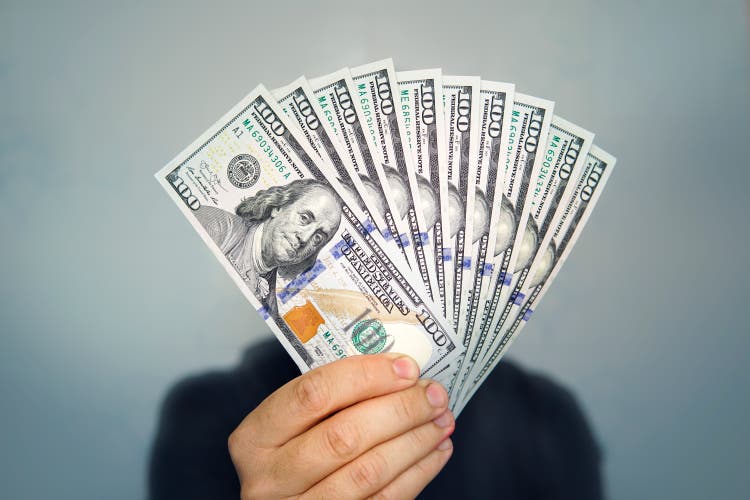
If you are searching for a gold hedge in your portfolio, also paying a high cash dividend yield, iShares MSCI Global Gold Miners ETF (NASDAQ:RING) may be the choice for you. This trust concentrates its holdings in the biggest, blue-chip gold miners in the world. The good news is this group of companies has decided to send out most earnings and free cash flow as a dividend payment, a radical change from past years. Looking forward, if gold prices begin to rise again, today’s 2.85% trailing yield is sustainable and may rise considerably in the future.
The Yield Story
Right now, RING is paying a dividend yield far above most alternative, diversified equity and bond-focused investments. Below is a 10-year chart of RING’s dividend yield vs. its main competitor in the space, VanEck’s Gold Miner ETF (GDX), and macro financial market setups from the SPDR S&P 500 ETF (SPY), Invesco NASDAQ 100 Trust (QQQ), iShares Russell 2000 ETF (IWM), iShares 20+ Year Treasury Bond ETF (TLT), and Vanguard Total Bond Market ETF (BND).
YCharts, RING Vs. Macro ETFs On Wall Street, Dividend Yields, 10 Years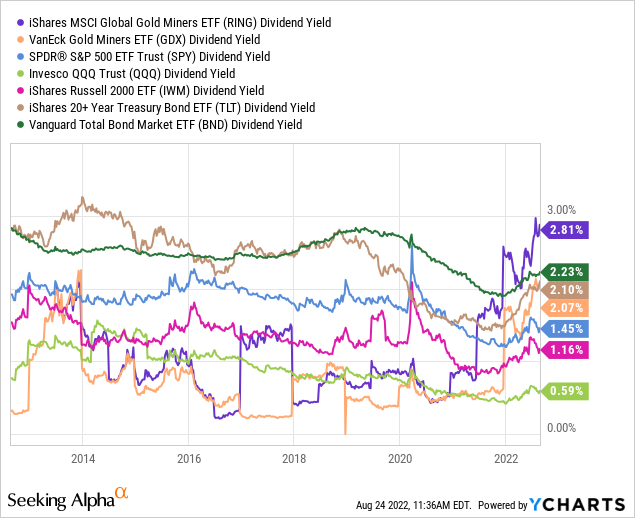
In addition, out of the group of mining ETF peers focused on diversification and major miner ownership, RING’s dividend can be called “top of the heap” and the kingmaker vs. competitors. Below is a 3-year graph highlighting RING’s winning dividend yield proposition vs. related alternatives. The iShares MSCI Global Gold Miners yield has moved from 0.5% to almost 3% over two years flat. [I would note that several ETFs focused on smaller junior miners are paying a dividend yield around 3% today, but at much greater risk for dividend cuts if gold prices do not rebound sharply into 2023.]
YCharts, RING Peer ETF Dividend Yields, 3 Years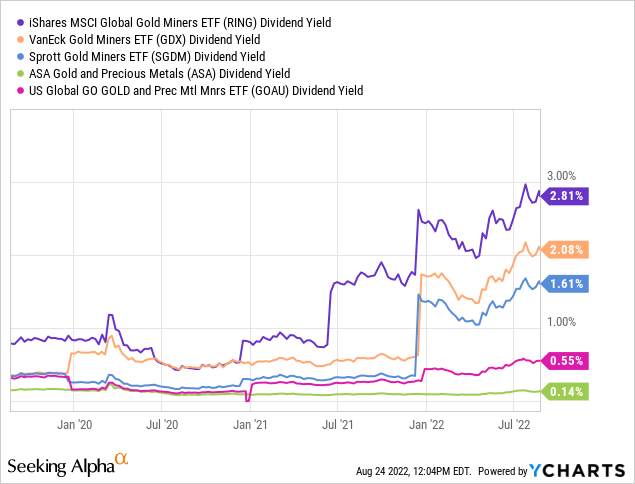
NEVER in my 35 years of trading have gold miners come close to matching the U.S. equity or bond market averages for cash distributions yearly, and such a case has not existed since the 1960s, at the earliest. The change in direction by industry management teams to pay out free cash flow to shareholders, instead of reinvesting it is a landmark decision. When you think about repercussions, the absence of reinvestment into exploration and production increases will likely drive gold prices higher eventually, as newly mined supply is already projected to have peaked globally over the last decade.
This high dividend payout decision should be a huge win for gold mining quotes and valuations in future years, especially if you own the biggest miners (like those in the RING ETF) with decades of economic in-ground reserves and resources at US$1750 an ounce gold.
Below is a table highlighting the RING concentration of mining ownership in the majors at the end of July. 42% of funds were invested in just three companies, Newmont (NEM), Barrick Gold (GOLD), and Agnico Eagle Mines (AEM). I personally like each of these names and own the group (and other miners) in my brokerage account. The beauty of RING is you can own the largest and most profitable gold miners in a single diversified investment vehicle, at low cost. The trust charges 0.39% annually for management of the ETF.
Seeking Alpha Table, Top 10 Holdings – RING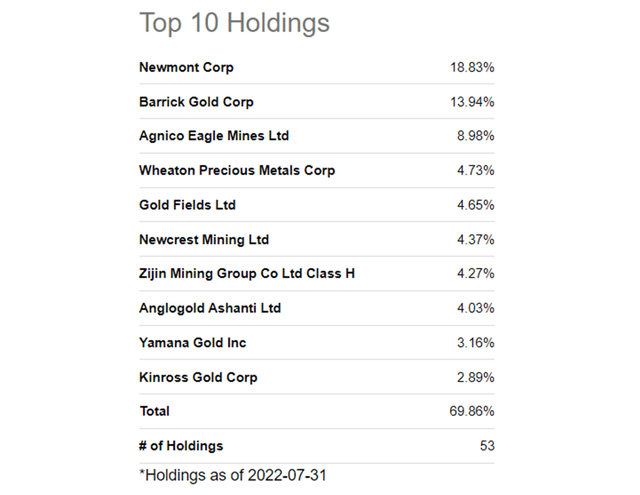
The trailing dividend yields for each of the Top 10 holdings is pictured below over the past year. A combination of oversized and extended price declines since the spring Russia/Ukraine war spike and a trend of raised dividend payouts has jumped the available yield for new investors in the gold mining space by greater than 50% since April.
YCharts, RING Gold Miner Holdings – Trailing Dividend Yields, 12 Months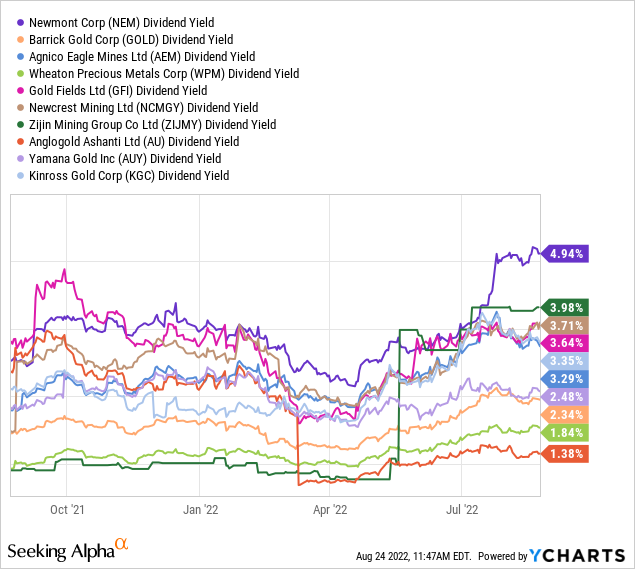
Technical Trading
There are no clear-cut technical signals of a bullish RING uptrend beginning soon. I am OK with this unproven chart, as gold miners sometimes lag actual metals pricing. Below is a 5-year chart of weekly trading action. Despite a 40%+ drop in price from Q3 of 2020, indications of deep selling do not exist in RING (or most precious metals vehicles). You can review how weekly readings and summations of buying/selling registered in the Accumulation/Distribution Line, Negative Volume Index, and On Balance Volume do not scream intense selling pressure. [I did write a bearish slant on Warner Bros. Discovery (WBD) a few weeks ago here, which showed real selling in these indicators on a weekly chart.]
StockCharts, 12-Month Daily Values, RING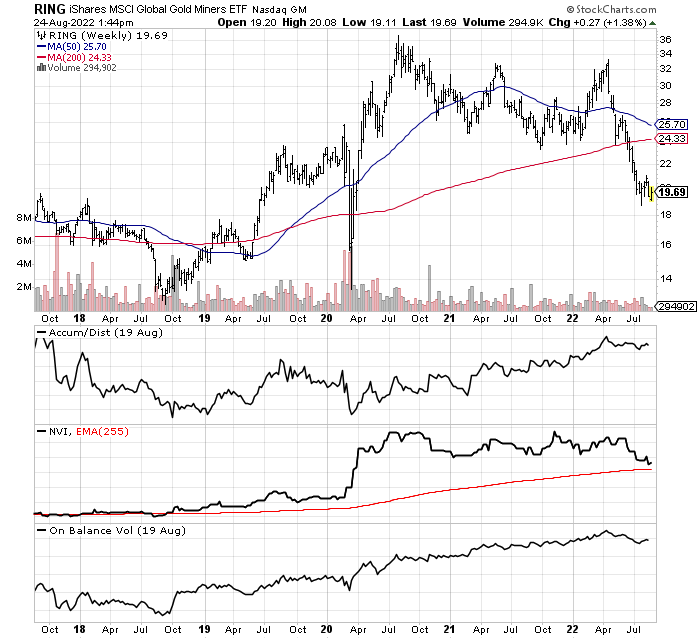
Already, pressure is building on gold prices to rise in the lease market, where banks, brokers, and large hedge funds trade and lend physical bullion. Lease rates based on the pricing of forward contracts for short-term borrowings (2-months) have risen above the rates on 12-month loans. Typically, this is a sign of supply tightness, which in turn causes gold to rise in price to find new supply. I have some charts drawn below to outline this idea. If history repeats (or at least rhymes per Mark Twain), gold could be bottoming in August 2022 and reversing strongly to the upside this fall. RING-RING… it’s your future calling with a request you buy gold assets right now? The last time the lease rate curve was this inverted was early 2020, just before gold bullion quotes rose 30% between February and September of that year.
Gold Charts R Us, Gold Lease Rates, 1-Year Graph Gold Charts R Us, Gold Lease Rates, 10-Year Graph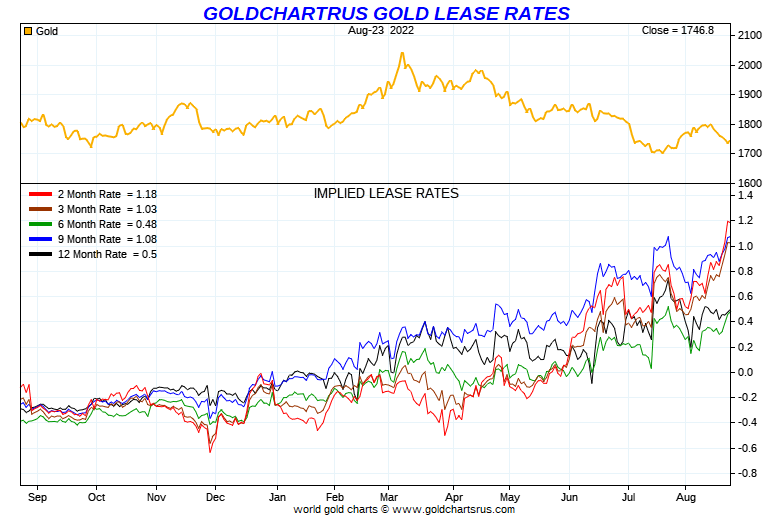
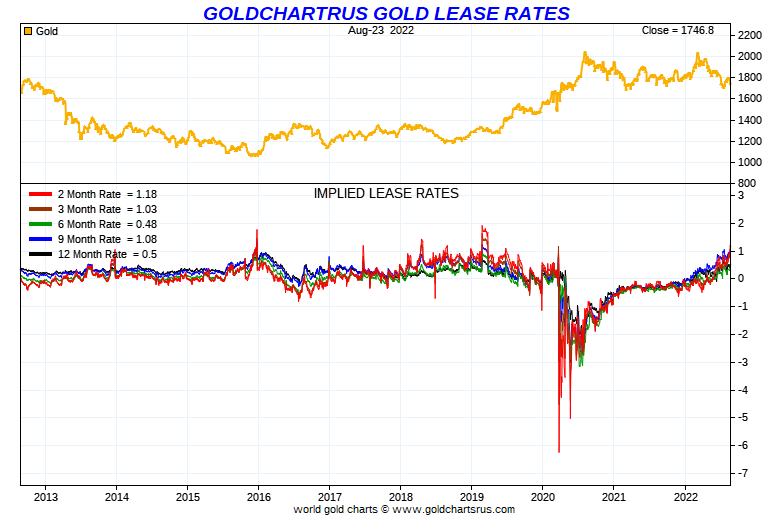
Final Thoughts
Many investors are unaware of the high-yield proposition now offered by gold miners. As an added bonus, the iShares MSCI Global Gold Miners trust serves as a long-term hedge against rising inflation rates (money printing), which also tends to benefit in price when geopolitical or financial market trouble hits the world. Under a variety of economic scenarios, RING could counterbalance the rest of your equity portfolio declining in value. Who doesn’t want a hedge position that pays a strong dividend yield while you wait?
My long-term working thesis remains gold (and other precious metals) will rise in price from a particularly low relative valuation today vs. other asset classes, and paper money/debt creation around the globe. [My last article here explained how silver is nearing an all-time low valuation.] If we are about to embark on a multi-year rise in gold, mining companies will likely rise many fold in price from today (which is historically the end result of leverage on rising bullion prices, created on years of reserves in the ground). If you believe a combination of yield and price appreciation creates the best total returns over time (like I do), RING deserves more research and perhaps a spot in your portfolio.
What is the main risk owning RING? I would say the single and most important downside risk is the price of gold. If gold quotes decline, miners with climbing costs over time will earn less profit. They may be forced to cut dividends. And, investors will be stuck with investment losses as a result. If you are bearish on the precious metals, especially gold, because of a stronger dollar or Fed tightening, I completely understand you might not have any interest.
However, gold usually bottoms when few are looking for a rebound, like today. Without doubt, a slowing U.S. economy and sinking stock market wealth effect matched against record debts (in aggregate vs. GDP) will not mix well. My view is the Fed will eventually have to deal with a recession and perhaps another financial crisis. It may be forced to renege on the 2022 tightening experiment (while accepting high rates of inflation as the new norm), and resume emergency money printing with free giveaways to borrowers. When that day comes, gold will explode higher as Wall Street rushes for monetary expansion hedges.
Thanks for reading. Please consider this article a first step in your due diligence process. Consulting with a registered and experienced investment advisor is recommended before making any trade.


Be the first to comment